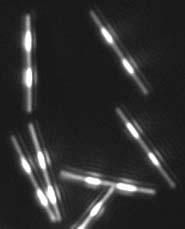
Cosmic lens magnifies faint galactic building-block.
Astronomers have peered deep into space and time and spotted a baby galaxy. Their results suggest that the tiny star-forming region may have helped to build today’s Universe 1 .
“We believe this is one of the galactic building-blocks that join together to make larger galaxies,” says Konrad Kuijken, of the Kapteyn Institute in Groningen, the Netherlands, a member of the team that found the object. The mergin

Sequencers expose secret chromosome centre.
February’s celebrations hid a dark secret: the human genome sequencers hadn’t touched the hearts of our chromosomes. Now, at last, one chromosome’s inscrutable midpoint, its centromere, has given up its genetic secrets.
Centromeres look like the ’waist’ in an X. They share out chromosomes fairly when a cell divides. Defective centromeres may underlie many cancers, in which problems with chromosome movement

Stripes help chemists shop for molecules.
Scientists may soon be sticking bar-coded metal rods into molecules to see what they do in a crowd 1 . The rods could help to track the functions and interactions of genes, and may aid drug discovery.
At only a few thousandths of a millimetre long, the rods are small enough to fit inside a single red blood cell. Christine Keating, of Pennsylvania State University, and colleagues cast them inside cylindrical pores in a

A new way to find genes and map disease.
A new technique should aid the hunt for genes in the human genome sequence. The method, which tracks only switched-on genes in cells, will help researchers to distinguish between diseased and normal tissues, and could point the way to new treatments.
Andrew Simpson, of the Ludwig Institute for Cancer Research in Sao Paulo, Brazil, and colleagues have produced a whopping 700,000 DNA tags, representing the genes that are active in 24 no

Spells and incantations step aside: scientists have found a genetic elixir of love. It makes males more faithful to females and more friendly to fellow males. It could also shed light on bonding disorders such as autism.
Larry Young of Emory University in Georgia and colleagues used a virus to deliver a gene straight to the part of voles’ brains responsible for rewards and addiction, the ventral pallidum. The gene made the animals’ brains more receptive to the hormone vasopressin 1

Museum exhibits’ genes record British forestry policies
Commercial forest planting in the north of England drew red squirrels westwards in the 1980s say UK researchers. This migration led to big changes in squirrel numbers and genetics.
The finding has implications for the protection of the endangered red squirrel (Sciurus vulgaris). Many conservationists advocate leaving ’wildlife corridors’ for animals to travel between patches of fragmenting habitat. This is the first evi

– new calculation confirms standard model of particle physics. Contribution of hadronic vacuum polarization determined with unprecedented accuracy. The magnetic moment of the muon is an important precision parameter for…
Technique may prevent formation of unwanted waves that siphon off needed energy. Heating plasma to the ultra-high temperatures needed for fusion reactions requires more than turning the dial on a…

An international team of astronomers, led by researchers from the Astronomical Observatory of the University of Warsaw, have identified a new class of cosmic X-ray sources. The findings have been…

Antibody that Neutralizes Inhibitory Factors Involved in Nerve Regeneration Leads to Enhanced Motor Function after Acute Spinal Cord Injury. Researchers at 13 clinics in Germany, Switzerland, the Czech Republic and…

How the body’s natural killer cells could fight leukemia. Every year, some 13,000 people in Germany are diagnosed with leukemia. Despite intensive chemotherapy, around one in two of them die….

… eco-friendly reactor converts air and water into ammonia. Producing enough ammonia to feed the world comes with a large carbon footprint;. process described in new UB-led study could help…

How simulations help manufacturing of modern displays. Modern materials must be recyclable and sustainable. Consumer electronics is no exception, with organic light-emitting diodes (OLEDs) taking over modern televisions and portable…

“Neurons that fire together, wire together” describes the neural plasticity seen in human brains, but neurons grown in a dish don’t seem to follow these rules. Neurons that are cultured…

The quest for sustainable energy solutions has been a major focus of scientific research for decades. Solar energy, a clean and renewable source, has emerged as a promising alternative to…

With a processing speed a billion times faster than nature, chip-based laser neuron could help advance AI tasks such as pattern recognition and sequence prediction. Researchers have developed a laser-based…

New technology could remotely identify various types of plastics, offering a valuable tool for future monitoring and analysis of oceanic plastic pollution. Researchers have developed a new hyperspectral Raman imaging…

Artificial Intelligence (AI) has established a strong presence across industries, large and small. The “VoBaKI” research project has empowered small and medium-sized enterprises (SMEs) with an innovative tool to independently…